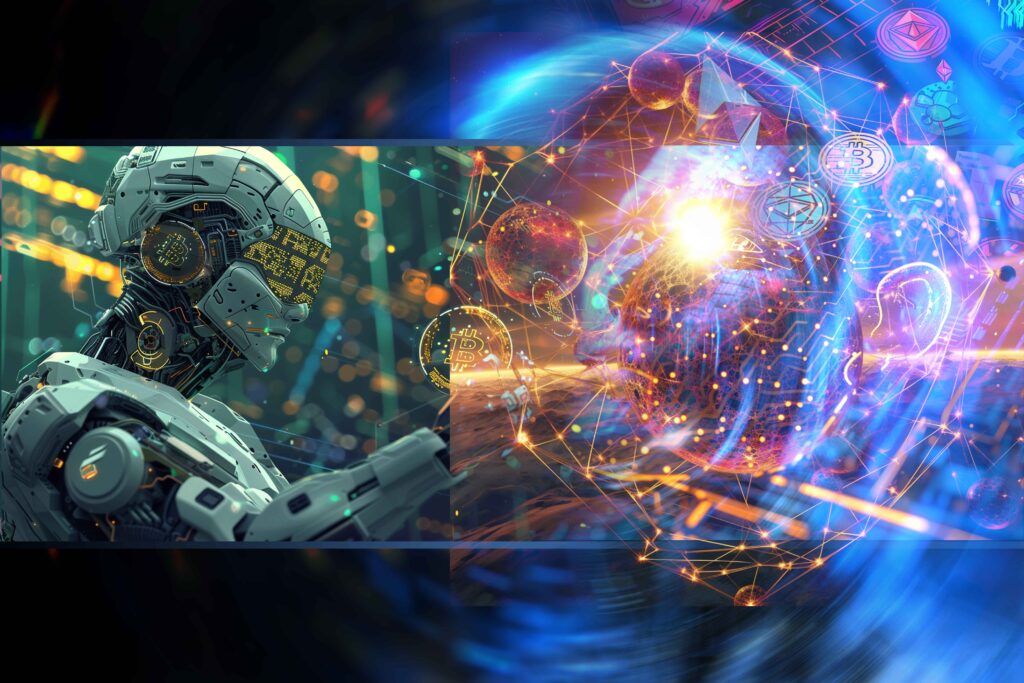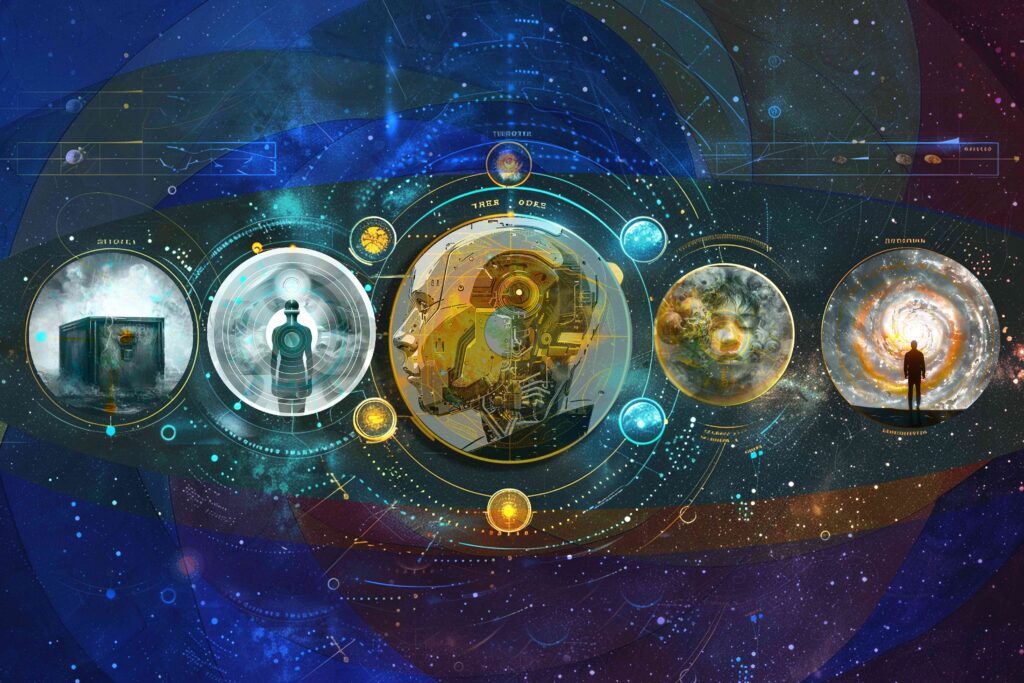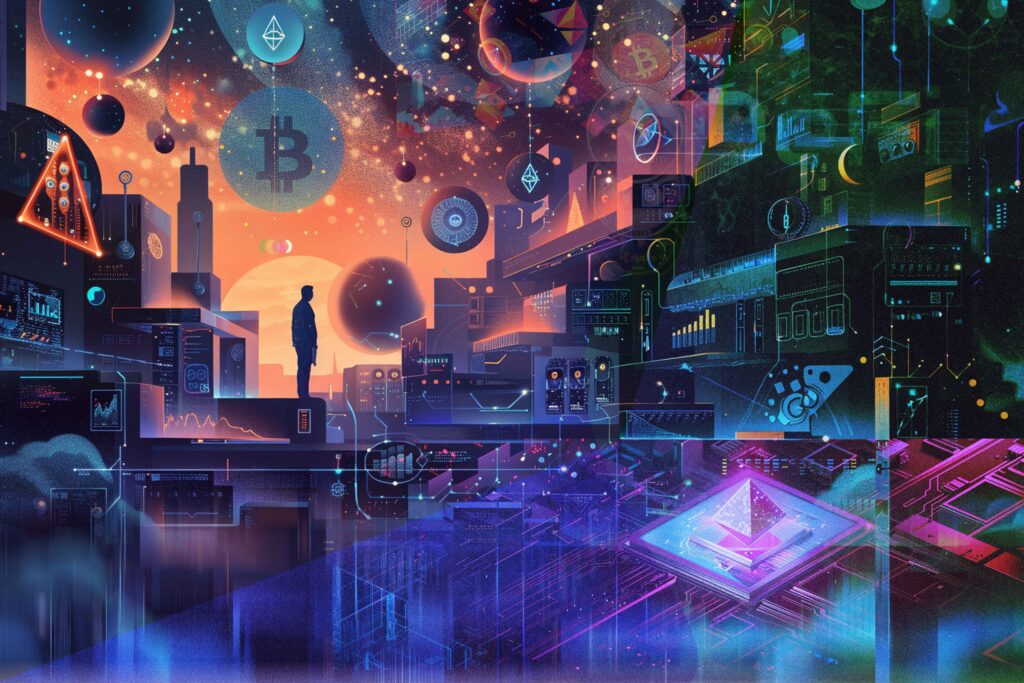Let us know your thoughts! Sign up for a Mindplex account now, join our Telegram, or follow us on Twitter.
Is Bigscreen Beyond Worth The Extra Money? | Highlights From S2EP9
Why the Odysseus Mission Is So Important | Highlights from S2EP10
Crypto AI Revenues Could Exceed $10 Billion by 2030
The integration of crypto incentives and blockchain technology with artificial intelligence (AI) could drive widespread adoption and advancement of decentralized AI and AI cryptos over the next decade, according to a new report by digital asset manager VanEck. Its timing couldn’t be better as we’ve been seeing an absolute explosion of AI-related cryptocurrency prices so far in 2024, the most recent rally coming on the back of OpenAI’s Sora launch.
In a recent in-depth report ‘Crypto AI Revenue Predictions by 2030’, VanEck analysts made several bullish predictions about the growth and the revenue potential of businesses operating at the intersection of crypto and AI. While any predictions should be taken with a grain of salt, considering where we’re at in the current crypto 2024 bull cycle, the report asks a lot of important questions and offers some surprising answers in the process.
Van Eck analyst Gabor Gurbacs has taken a controversial stand against AI, predicting its misuse will result in the biggest spam attacks the world has ever seen. Gurbacs sees Bitcoin as its only salvation, so read on to find why.
Public Blockchains Uniquely Positioned to Aid AI Progress
The Van Eck report is extremely bullish on the benefits that blockchain can bring to AI. He feels that AI and AI Agents “provide the raison d’être” for blockchain technology. It’s a big statement, but backed up by some sound reasoning: blockchain networks like Bitcoin and Ethereum possess several key attributes that make them well-suited to address existing challenges facing the AI industry, most notably:
- Transparency – Being public ledgers recording all transactions, blockchains enable oversight related to data usage, model ownership, etc. This supports trust and accountability.
- Immutability – Records made on blockchains cannot be altered afterwards. This immutability lends integrity to data used for critical model training and testing.
- Ownership – Tokens, NFTs, and smart contracts allow us to clearly define ownership rights related to data, models, and even model outputs.
- Adversarial Testing Environment – The adversarial, incentivized environments of crypto networks that financially reward hacking and optimization force rigorous, real-world testing of systems.
He projects that these properties of blockchain will speed up the adoption of, and trust in, AI over the next seven years.
Crypto Market Share of AI Could Reach Billions Annually
Applying economic and productivity growth assumptions to previous McKinsey research, Van Eck predicts a total addressable market (TAM) for global productivity gains enabled by AI automation will clock a crazy $5.85 trillion in 2030. Assuming 33% adoption by businesses worldwide, annual AI revenues could top $250 billion within the decade.
Moreover, the report forecasts crypto’s potential market share across major AI business categories:
- Software: $6.27 billion
- Infrastructure/Compute: $1.9 billion
- Identity: $878 million
- Safety/Compliance: $1.12 billion
Tallying these up, it’s predicted that annual crypto AI revenues could approach $10.2 billion by 2030 in VanEck’s base case. Under more aggressive assumptions about adoption and market capture, AI cryptocurrencies’ stake could exceed $50 billion.
How blockchain helps AI solve identity issues
Artificial intelligence is increasingly critical to the global economy, akin to an essential utility. Web2 giants like Amazon and Google dominate current AI infrastructure, while blockchain technology supports specific, high-demand needs with its decentralized approach, offering flexibility and customization for AI development. This scenario positions blockchain as a dynamic adjunct in the AI infrastructure market, similar to how ride-sharing platforms like Uber complement, rather than replace, traditional transport services.
The importance of secure AI identities is rising, with blockchain playing a key role in preventing Sybil attacks by establishing verifiable digital identities. This defense is crucial as AI applications extend into areas like autonomous vehicles and healthcare, where safety is paramount.
Blockchain’s immutable records serve as reliable “proofs of safety,” essential for high-stakes accountability and compliance. Despite blockchain’s potential to revolutionize AI safety and identity verification, a significant portion of this market is expected to stay centralized, preferring established reliability and trust in sensitive sectors.
Bitcoin miners find surprising synergy with the AI sector
Bitcoin miners, traditionally focused on mining proof-of-work cryptocurrencies like Bitcoin, are diversifying into the AI sector due to their shared high energy consumption needs. These miners have historically invested heavily in energy infrastructure, often utilizing cost-effective but carbon-intensive power sources. This positions them uniquely to offer lower-cost energy solutions for AI’s backend infrastructure, contrasting with Big Tech’s move towards renewable energy and vertically integrated operations.
As AI’s energy demands potentially outpace current projections, bitcoin miners’ cost advantage in electricity could become increasingly significant, prompting a shift towards providing high-margin AI services, particularly in GPU provisioning.
Companies like Hive, Hut 8, and Applied Digital are leading this transition, with some reporting substantial revenue growth from AI-related operations compared to traditional bitcoin mining.
For instance, Hive’s AI operations are notably more profitable on a per-megawatt basis. However, despite the promising shift and potential for revenue diversification, bitcoin miners face challenges in scaling up for AI, including skills gaps in data center construction, the need for a specialized salesforce, and limitations imposed by network latency and bandwidth in remote locations. These hurdles could impede their pivot to AI, despite the opportunities in the sector.

Notable Blockchain Use Cases Emerging Across the AI Landscape
Public blockchains and crypto token incentives have already sparked solutions addressing several pressing needs for progress across the AI landscape:
Decentralized Compute/Infrastructure
Projects like Akash, Render and Bittensor provide decentralized cloud computing platforms and infrastructure to help supply scarce GPUs for AI model training and deployment. This helps to pull down current limitations around access, cost, security, and customization options.
Model Optimization
Protocols like Numerai use tokenized incentives to organize data science competitions aimed at building optimized models for tasks like quantitative finance or natural language processing. Crypto tokens reward the most accurate and effective models.
Data Integrity
Emerging zero-knowledge proof solutions from startups like MODA allow AI model owners to mathematically prove certain claims about data usage or model performance without revealing proprietary intellectual property or sensitive information. This supports copyright protections and model accountability.
Digital Identity
Initiatives like WorldID (with its Worldcoin cryptocurrency) – spearheaded by AI thought leader Sam Altman from OpenAI and Sora – controversially leverage blockchain and biometrics to establish verified digital identity firmly linked to real humans. As automation increases, reliably determining humanity could help ensure security for computer networks and systems.
Conclusion
In summary, crypto-based networks already demonstrate clear potential to overcome some of the hardest barriers holding back innovation and mainstream adoption in artificial intelligence. However, integrating these two exponentially advancing technologies comes with persistent technical and adoption challenges.
If solutions continue maturing at their current brisk pace, crypto and AI seem well positioned to drive tremendous value for one another over the next 7 to 10 years. But uncertainties and speculation still cloud the most aggressive growth projections put forth. According to VanEck, the base case for 2030 remains strong, but the roadmap to billions in annual revenue still requires some visionary bets on both technologies to pay off.
Let us know your thoughts! Sign up for a Mindplex account now, join our Telegram, or follow us on Twitter.
Matteo Borri: Alien Life | Mindplex Podcast – S2E10
Universal Human Values and Artificial General Intelligence
The field of value alignment is becoming increasingly important as AGI developments accelerate. By alignment we mean giving a generally intelligent software system the capability to act in a way that is beneficial to humans. One approach to this is to instill AI programs with human values.
However, the research in this field tends to focus on algorithms for maximizing metrics like pleasure or happiness. Much less attention has been devoted to the actual set of values they should follow.
I propose that the evidence from worldwide religions, traditional philosophy, evolutionary psychology and survey research finds surprising agreement on basic human values. Abstracting from this work, I propose a five-tier system of values that can be applied to an AGI.
Level 1 is the values of life, survival, and persistence. It evolves from a concern for living and reproducing. An agent acts to avoid destruction, seek out energy and pass on characteristics to a future generation.
Level 2 contains truth, wisdom, and knowledge. It is about agents that value truth and the ability to understand and interact well with their immediate surroundings.
Level 3 is a bundle of three sets of values concerning oneself: freedom, temperance, and growth. These values affect the agent’s internal state and behavior. The ‘self’ in question might be a human being or an AI designed as an autonomous moral agent.
Level 4 is a bundle of five values: empathy, authority, security, justice, and conformity. These are all concerned with group interaction. They apply to biological fellow beings or to multi-agent AI systems.
Level 5 contains values for dealing with nature and the surrounding ecosystem as well as the universe beyond. A sufficiently powerful general intelligence could have a terrestrial and extra-terrestrial impact and so needs to be concerned with the larger environment.

The values are concentric – they start with fundamental metaphysical and epistemological assumptions and radiate outwards to be more inclusive in space, in time, and in variety.
However there are a number of unresolved issues:
- Universality – The debate of moral relativism vs. moral universalism in which different values are emphasized or traded off.
- Hierarchy – The ranked order of the values in terms of their importance or goal relevance.
- Change – Ethics for a transhuman or posthuman society might necessitate alterations due to changes in the nature of humanity or other AIs.
- Human centricity – These values are human and created by our unique evolution and societal organizations.
- Consciousness – Agents may need to feel – to have qualia – in order to be morally responsible. This does not mean that an AGI cannot act morally.
- Implementation – This listing of said values does not describe the mechanisms by which they can be instantiated.
In light of these challenges and opportunities within the realm of value alignment in AGI, the upcoming Beneficial AGI Summit emerges as a pivotal platform. The BGI Summit, with its gathering of leading minds in artificial intelligence, ethics, and related fields, presents an unparalleled opportunity to delve deeper into these unresolved issues.
The universality of values, the hierarchy of ethical considerations, the evolving nature of ethics in a transhuman society, the human-centric viewpoint, consciousness, and the practical implementation of these values in AGI systems – all these topics are ripe for discussion at the BGI Summit.
This event could mark a significant step forward in our understanding and ability to integrate these complex value systems into AGI, fostering a future where artificial intelligence compliments and enhances human values and ethics. Join me at the BGI Summit to explore these topics. For more information and to register visit bgi24.ai
Let us know your thoughts! Sign up for a Mindplex account now, join our Telegram, or follow us on Twitter.
NEOLAF: Introducing a Never-Ending Learning Framework for Intelligent Agents
The article “NEOLAF: A Neural-Symbolic Cognitive Architecture for Generalized Intelligence” introduces an integrated neural-symbolic cognitive architecture aimed at modeling and constructing intelligent agents. Unlike traditional approaches such as pure connectionist or symbolic models, NEOLAF stands out for its unique features, including superior explainability, incremental learning, efficiency, collaborative and distributed learning, human-in-the-loop enablement, and self-improvement. This study highlights the advanced learning capabilities of the framework with a captivating experiment featuring a NEOLAF agent tasked with tackling challenging math questions from the MATH dataset.
NEOLAF serves a broad purpose in constructing intelligent agents, particularly self-improving intelligent tutor agents within adaptive instructional systems. Inspired by human cognitive development, NEOLAF combines the best features of both connectionist (ChatGPT, for example) and symbolic (SOAR, ACTR) techniques to overcome the shortcomings of each paradigm. The framework is a flexible tool for creating intelligent agents because of its unique benefits, which include explainability, incremental learning, efficiency, collaborative learning, and self-improvement.
The methodology behind NEOLAF involves instantiating learning agents from a DNA-like starter kit, leveraging pre-trained large language models (LLMs) for foundational reasoning. Like human cognition, NEOLAF agents function on two cognitive levels: rapid and slow. As a depiction of the knowledge-experience duality, the KSTAR framework (Knowledge, Situation, Task, Action, Result) is presented, enabling agents to learn via ongoing, iterative, and multitasking procedures.
NEOLAF agents exhibit two types of memory: implicit memory, which involves offline knowledge injection for model fine-tuning, and explicit memory, which represents past knowledge stored through the KSTAR process for each encounter. Like humans consolidate their memories as they sleep, NEOLAF agents can consolidate knowledge thanks to this dual-memory architecture.

Building on related work in the chain of thought reasoning, NEOLAF incorporates recent advances in LLM, reinforcement learning (RL), multitask learning, and planning to conduct tasks in the KSTAR process. The study describes a preliminary implementation of NEOLAF for a math problem-solving agent and evaluates its effectiveness against other models, like ChatGPT. The experiment uses difficult questions from the AIME and USAMO Math Competitions to assess different performance measures.
Beyond its application to math problem-solving, NEOLAF is envisioned as a cognitive architecture for an agent-based learning environment (Open Learning Adaptive Framework – OLAF). OLAF creates a dynamic and interactive learning environment by integrating three types of agents: learners, human teachers, and AI agents.
In summary, the NEOLAF architecture combines system-1 LLM capabilities with system-2 explicit reasoning and external services, which is a breakthrough approach to AI. NEOLAF solves significant issues with conventional methods by utilizing a dual-memory architecture and the KSTAR representation for problem-solving. Beyond addressing mathematical problems, the framework may be used to develop co-habitat ecosystems called BotLand and multimodal reasoning, which will promote interaction and evolution between intelligent agents and humans. NEOLAF emerges as a lightweight and continually improving AI model, offering a promising alternative to current leading LLMs that are expensive to train and maintain.
Let us know your thoughts! Sign up for a Mindplex account now, join our Telegram, or follow us on Twitter.
Raising The Bar: Apple Vision Pro Sets A New Higher Standard | Highlights from S2EP9
The A-Z of Crypto Tools To Explore DeFi and Web3
Introduction
The crypto landscape has undergone some huge changes following 2020’s DeFi Summer and the ensuing 2021 bull run. Gone are the days when you could simply buy and sell (or HODL) the top ten coins at the most opportune times and retire soon after. With the 2024 crypto bull run starting due to the launch of Bitcoin spot ETFs and the looming Bitcoin Halving which could raise all boats, DeFi degens who want to strike it rich like early Bitcoin investors must now be smarter and look beyond the action on boring old centralized exchanges, in order to find those 10x and 100x opportunities.
To do this, they use a plethora of innovative data research and trading tools that give them precise on-chain analytics, detailed airdrop gameplans, project news and announcements, and more.
Here are some of the most popular ones, excluding trading bots, but please note that none of these are endorsed by Mindplex Magazine, and are shared for educational purposes only. Only connect your crypto wallets to any of these tools once you’ve done your research on them and always be vigilant against malicious phishing sites that could drain your entire portfolio.
Airdrops.io: Timely Cryptocurrency Airdrops
- Best feature: Timely information on cryptocurrency airdrops.
- Cost: Gratis.
- How it works: Community airdrops are a huge narrative in 2024, but it takes plenty of research to know which protocols to target. Airdrops.io is a dedicated platform for crypto enthusiasts looking for the latest airdrop opportunities. It provides detailed information about ongoing and upcoming airdrops, making it easier for users to participate and potentially receive free tokens. The site categorizes airdrops by type (such as DeFi, NFT, etc.), ensuring users can find opportunities that align with their interests and investment strategies.
Artemis.xyz: Comprehensive Crypto Analytics
- Best feature: Aggregates data from various sources for comprehensive analytics.
- Cost: Gratis
- How it works: Artemis.xyz stands as a comprehensive analytics platform, aggregating data from exchanges, social media, and more, to offer investors a broad view of the market for well-informed decision-making.
BanterBubbles: Visualizing Crypto Performance
- Best feature: Visualizes performance of cryptocurrencies in a unique format.
- Cost: Free
- How it works: BanterBubbles offers a visually engaging way to comprehend market trends, using bubbles to represent performance data, making it an intuitive tool for grasping market dynamics at a glance. BanterBubbles goes beyond the original CryptoBubbles by featuring niche sector views and an interactive comment section that pools together research from the Crypto Banter community.
Chainalysis: The Crypto Detectives
- Best feature: Advanced blockchain analysis for tracking the flow of digital assets.
- Cost: Freemium
- How it works: Chainalysis is renowned for its blockchain analytics tools, providing transparency and insight into the movement of digital assets, essential for compliance, research, and understanding complex blockchain ecosystems.
CoinAlyze: Spotting Altcoin Trends
- Best feature: Spotting changes in open interest.
- Cost: Gratis
- How it works: CoinAlyze caters to those focused on the derivatives market, offering critical data on open interest changes that can signal market sentiment shifts, essential for altcoin traders.
Coin Lobster: Simplified DeFi Analytics for Beginners
- Best feature: Simplified analytics for beginners.
- Cost: Free
- How it works: Designed for simplicity, Coin Lobster breaks down complex DeFi analytics, providing insights into futures markets, liquidations, and significant trades, making it accessible for newcomers.
CoinMarketCap: Cryptocurrency Market Rankings
- Best feature: Extensive database of cryptocurrencies with market rankings, price charts, and volume data.
- Cost: Gratis.
- How it works: CoinMarketCap and others like CoinGecko are leading cryptocurrency information websites that offer detailed data on thousands of digital currencies. It includes market cap rankings, historical data, exchange volumes, and more, serving as an essential research tool for investors looking to make informed decisions. Its user-friendly layout and comprehensive coverage of the crypto market have made it a go-to resource for both beginners and experts alike. These sites also compete with each other to roll out new features frequently.
Coinstats.app: Real-Time Crypto Data
- Best feature: Real-time crypto market data and portfolio tracking.
- Cost: Gratis version available; premium plans offer additional features like advanced analytics and exclusive insights.
- How it works: CoinStats.app is a comprehensive cryptocurrency portfolio tracker and market data provider that offers real-time price updates, news, and detailed analysis across thousands of cryptocurrencies. It’s designed to help investors manage their investments across multiple wallets and exchanges, providing a unified view of their portfolio’s performance. The platform’s intuitive interface and mobile app make it accessible for monitoring investments on the go. Please understand what you’re doing and don’t give portfolio sites like CoinStats unfettered API access to your exchange and private wallets and the ability to execute transactions on your behalf, as it could potentially be hacked.
CryptoFees.info: Understanding Revenue Generation
- Best feature: Insights into project revenue generation.
- Cost: Gratis
- How it works: CryptoFees.info offers a simple yet effective way to understand which DeFi projects are generating significant revenue, aiding investors in identifying sustainable and potentially profitable ventures.
CryptoQuant: In-Depth Market Insights
- Best feature: Offers data on spot and derivatives markets, and on-chain metrics.
- Cost: Free, with paid plans for additional features
- How it works: CryptoQuant caters to the analytical needs of both institutional and individual investors, providing a wide array of data points including on-chain metrics, market analysis, and trading indicators for strategic investment planning.
DappRadar: Decentralized App Data Heaven
- Best feature: Personalized tables for DeFi protocols.
- Cost: Gratis
- How it works: As a very popular DApp market explorer, DappRadar simplifies the discovery and analysis of NFT, DeFi, and more, making it easier for users to compare different protocols and streamline their investment strategies.
DeBank: The Web3 Messenger and Tracker
- Best feature: Tracking of on-chain Web3 activity.
- Cost: Gratis
- How it works: DeBank provides a streamlined interface for portfolio tracking and on-chain activity monitoring, allowing users to follow influential investors and gain insights into prevailing market trends.
DeFi Llama: Onchain Alpha in One Spot
- Best feature: Comprehensive tracking of TVL across various chains.
- Cost: Gratis
- How it works: A one-stop dashboard offering insights into the crypto market dynamics, DeFi Llama tracks the Total Value Locked across different chains, providing a macro view essential for spotting trends and identifying opportunities.
DeFiPulse: Tracking and Analytics for DeFi
- Best feature: Tracking and analytics for DeFi projects and Total Value Locked (TVL).
- Cost: Gratis.
- How it works: DeFiPulse is a key resource for those interested in the decentralized finance (DeFi) space. It ranks DeFi platforms based on the total value locked (TVL), providing insights into the most popular and successful projects. The platform also offers information on yield farming, lending rates, and other DeFi metrics, making it invaluable for investors looking to dive into the DeFi ecosystem.
Delphi Digital: In-Depth Crypto Research and Analysis
- Best feature: Expert-led research and strategic insights into the crypto market.
- Cost: Membership-based, with different tiers for individual and institutional access.
- How it works: Delphi Digital stands out as a premier research boutique specializing in the digital assets market. The platform combines deep industry knowledge with data-driven analysis to offer comprehensive reports, investment strategies, and market forecasts. Catering to both individual investors and institutions, it provides actionable intelligence on various aspects of the crypto ecosystem, including DeFi, NFTs, and emerging blockchain technologies.
DEXTools: Real-Time Data for DeFi Traders
- Best feature: Insights and historical charts for informed decision-making.
- Cost: Gratis
- How it works: DEXTools is a robust platform offering real-time data from decentralized exchanges, equipped with features that support traders through insights, charts, and alerts, enhancing DeFi trading decisions.
Dune: The Community Research Hub
- Best feature: User-generated scripts and data.
- Cost: Gratis
- How it works: Dune Dashboards empowers its users with the ability to create, share, and explore custom data visualizations, offering a decentralized platform for deep-diving into blockchain analytics through community-sourced insights.
Instadapp: DeFi Protocol Aggregator
- Best feature: Seamless management of multiple DeFi protocols.
- Cost: Free to access, with transaction fees applicable for certain actions.
- How it works: Instadapp provides a unified interface that simplifies the management of assets across various DeFi protocols. It enables users to optimize their DeFi strategy by leveraging functionalities like asset swapping, leverage adjustments, and debt management in one platform, making it easier to navigate the complex DeFi ecosystem.
KyberSwap: Real-Time and AI Insights for Trading
- Best feature: Real-time insights with Kyber AI.
- Cost: Gratis
- How it works: KyberSwap leverages AI to provide predictive market insights and trend analyses, offering a competitive edge to traders looking for real-time data to refine their strategies.
LunarCrush: Social Media Analytics for Crypto
- Best feature: Real-time social media analytics and market sentiment.
- Cost: Gratis, with premium features for advanced users.
- How it works: LunarCrush collects and analyzes data from social media to gauge market sentiment and trends for various cryptocurrencies. By leveraging AI and machine learning, it offers insights into user engagement and sentiment, helping investors make informed decisions based on the social dynamics of crypto markets.
Nanoly.com: The APY Hub for DeFi Yield Chasers
- Best feature: Maximizing staking returns.
- Cost: Gratis
- How it works: Nanoly directs users to the highest APY opportunities for staking their crypto, an invaluable resource for those looking to optimize their yield farming strategies in a risk-aware manner.
Nansen: Advanced Crypto and NFT Analytics
- Best feature: Advanced on-chain data analytics.
- Cost: Gratis, with paid advanced options
- How it works: Nansen stands out for its wallet and token activity tracking, providing alerts and insights that help users make informed investment decisions, especially in the NFT space. By combining blockchain data with an array of proprietary analytics tools, users can identify emerging trends, track smart money movements, and uncover investment opportunities across various blockchain ecosystems.
The platform’s dashboard offers visualizations of on-chain data, making it accessible for both novice users and experienced analysts. Nansen segments data into actionable insights, allowing users to monitor wallet addresses, decipher market signals, and follow the strategies of successful investors.

NFTGo.io: NFT Market Analytics and Discovery Platform
- Best feature: Comprehensive NFT market analysis and trend tracking.
- Cost: Gratis basic access; premium features for advanced insights.
- How it works: NFTGo offers a wide array of tools and data for users to explore and analyze the NFT market comprehensively. The platform aggregates NFT data across multiple blockchains, providing insights into trading volumes, price trends, and market movements. Users can discover hot collections, track whale activities, and utilize rarity tools to assess NFT value. The platform aims to democratize access to NFT market data, making it easier for collectors, investors, and creators to make informed decisions.
Nomis: Interest Rate Optimization
- Best feature: Optimizing interest rates for savers and borrowers in DeFi.
- Cost: Free to use, with possible fees for executing transactions.
- How it works: Nomis serves as a platform for optimizing interest rates for users looking to either save or borrow in the cryptocurrency space. It aggregates and analyzes interest rates across various DeFi protocols, providing recommendations to help users maximize returns or minimize borrowing costs, thereby enhancing the efficiency of capital allocation in DeFi markets.
OnChainBlock: On-Chain Data and Analysis
- Best feature: Detailed blockchain analytics for data-driven decision-making.
- Cost: Free access to basic features; subscription model for advanced analytics.
- How it works: OnChainBlock specializes in providing on-chain data and analysis across multiple blockchains. It offers tools for tracking wallet activities, transaction trends, and network health, catering to analysts and investors seeking to base their strategies on granular blockchain data.
SolanaCompass: Analytics for the Solana Ecosystem
- Best feature: Dedicated analytics and insights for Solana blockchain.
- Cost: Gratis, with potential premium features for specialized insights.
- How it works: SolanaCompass focuses exclusively on the Solana ecosystem, offering analytics, project tracking, and network statistics to investors and developers. It provides real-time data on transactions, dApps, and token performance within the Solana network, enabling stakeholders to make informed decisions within this high-performance blockchain environment.
TokenMetrics: AI-Based Crypto Investment Research
- Best feature: AI-driven cryptocurrency analytics and forecasts.
- Cost: Subscription-based, with multiple tiers offering different levels of access and services.
- How it works: TokenMetrics uses artificial intelligence to analyze and predict crypto market trends. It provides a comprehensive suite of tools, including market predictions, portfolio management, and investment strategies, tailored to help users from novice to expert maximize their investment potential by leveraging data-driven insights.
Token Unlocks: Capitalizing on Circulating Supply Changes
- Best feature: Track token unlocks to capitalize on changes in circulating supply.
- Cost: Gratis
- How it works: Don’t become exit liquidity for early investors in a DeFi project who dump their vested tokens as soon as they receive them. Token Unlocks provides essential information on token release schedules, aiding investors in anticipating market impacts driven by fluctuations in token supply, a critical factor for strategic planning.
Uniswap Info: DeFi Trading at Your Fingertips
- Best feature: Detailed analytics and trading volumes for Uniswap pairs.
- Cost: Free
- How it works: Uniswap Info delivers in-depth analytics for the Uniswap protocol, allowing traders to track performance, liquidity, and trading volumes, essential for anyone deeply involved in DeFi trading on Uniswap.
Youtube: Long-form Crypto Education and Insights
- Best feature: Diverse content on crypto education, news, and analysis.
- Cost: Free access to content; costs may vary for premium or exclusive content.
- How it works: Crypto Youtube is an essential crypto research tool that encompasses a broad range of channels and content creators dedicated to cryptocurrencies, blockchain technology, and digital finance. Get anything from coin deep dives to detailed market analysis, project previews and reviews, and real-time news. You could almost say, hear about it on Twitter, learn about it on YouTube.
Viewers can also find content tailored to various levels of expertise, from beginner tutorials on blockchain fundamentals to advanced trading strategies and technical analysis by following excellent channels such as CoinBureau.
Content creators range from experienced traders and crypto enthusiasts to blockchain developers and fintech experts, providing a rich tapestry of perspectives and insights. Channels may offer live streams, Q&A sessions, community discussions, and interviews with industry leaders.
Be wary though of believing everything you hear. That’s because content creators, also called KOLs or influencers, are often very biased and shill the projects they’re invested in or getting paid by, as the controversial recent SatoshiVM launch highlighted again.
Zapper.fi: Your DeFi Dashboard
- Best feature: Manage and track your DeFi assets and liabilities in one place.
- Cost: Free
- How it works: Zapper.fi simplifies DeFi portfolio management, offering users a unified dashboard to track and manage their assets and liabilities across numerous protocols, enhancing the DeFi investment experience.
Messari: Crypto Data and Research
- Best feature: Comprehensive crypto market data and in-depth research.
- Cost: Gratis basic access; premium subscription for advanced insights.
- How it works: Messari is one of the most respected names in crypto, thanks to the wealth of information it offers on cryptocurrencies and sectors, including market data, project overviews, and research reports. It aims to provide transparency and actionable insights to investors and market participants through tools for tracking, analyzing, and discovering trends in the crypto market.
Conclusion
Each of the platforms in our A-Z DeFi Tool List (which we’ll update from time to time) brings a unique angle to how we can understand and manage our cryptocurrency investments and strategies. From protocol aggregators and market data providers to AI-driven analytics and dedicated ecosystem tools, the breadth of resources available to crypto enthusiasts and investors continues to grow, giving retail investors institutional-grade insights and opportunities that are there for the taking if you can connect the dots.
Let us know your thoughts! Sign up for a Mindplex account now, join our Telegram, or follow us on Twitter.











.png)

.png)


.png)